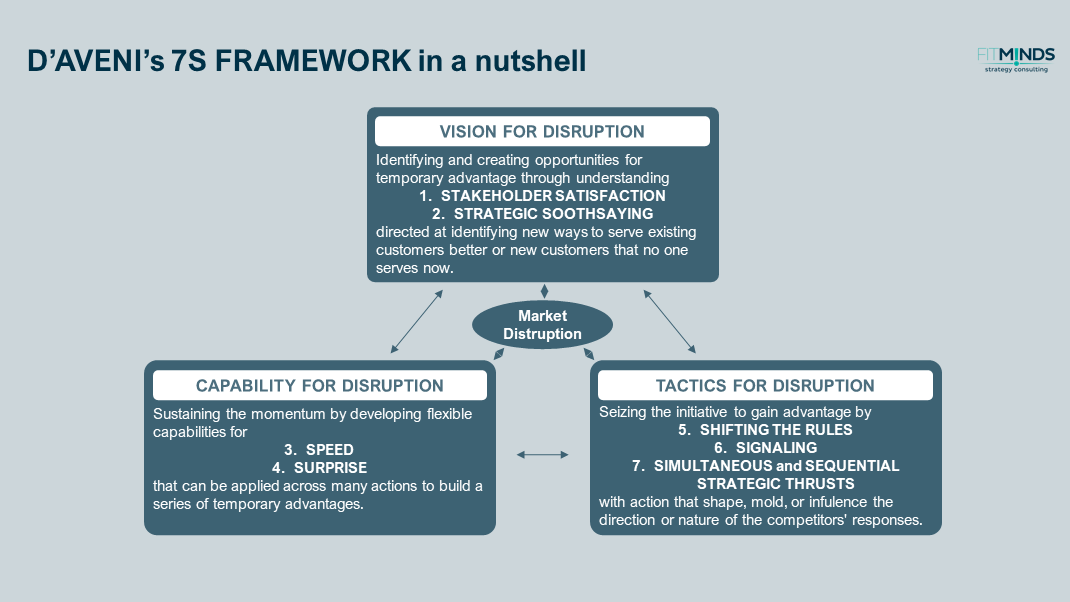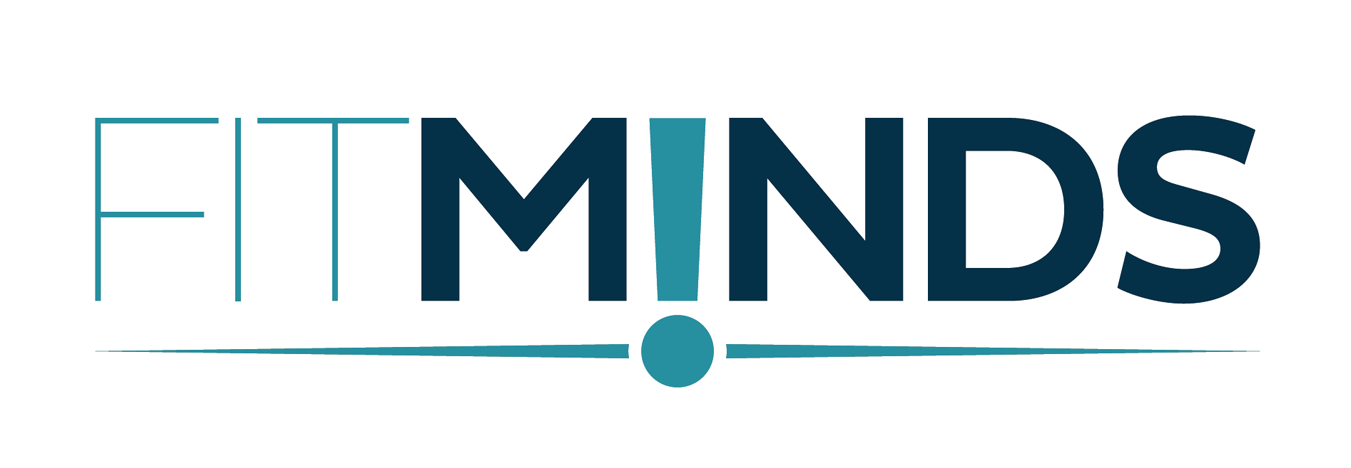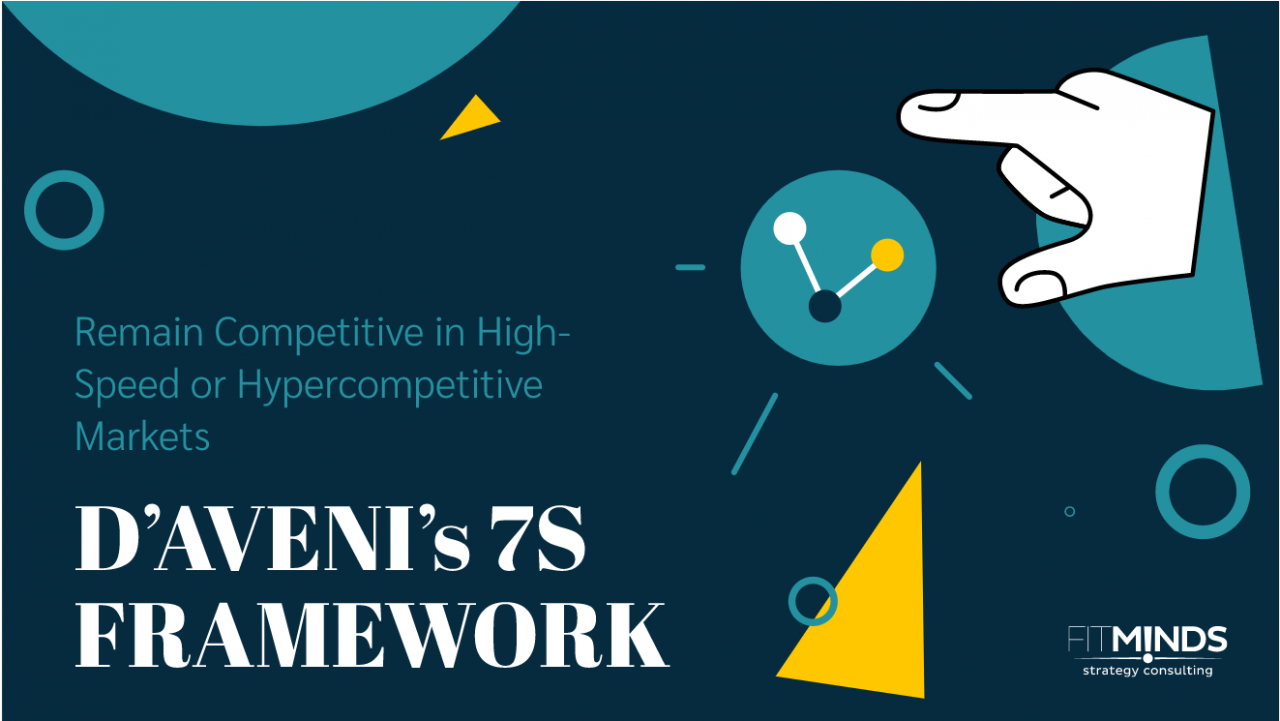The 7S framework, developed by Richard A. D’Aveni, is a set of approaches to direct an organization in high-speed or hypercompetitive markets.
Main Benefits of D’Aveni’s 7S Framework
D’Aveni’s 7S framework helps you:
- put disruption in the center of your business strategy,
- compete in the market in an unexpected manner,
- force your organization out of traditional competitive action sets.
Explanation of D’Aveni’s 7S Framework

According to D’Aveni, hypercompetition is a market state in which maintaining a competitive advantage is almost impossible due to escalating competition in every aspect. Factors, some of which stated below, make competitive advantages disappear in a short time:
- Fragmentation of customer preferences
- Rapid technological change
- Erosion of geographical and industrial boundaries due to globalization
- Deep pockets among competitors due to giant alliances…
Therefore, rather than trying to sustain competitive advantages, firms should focus on proactively disrupting both their own and their competitors’ advantages in today’s hypercompetitive environment. 7S Framework offers 7 approaches for firms to disrupt continuously.
The first two S’s are about “vision for disruption”.
1. Stakeholder satisfaction: A disruption must satisfy two conditions to be successful:
-
- creating a temporary advantage to serve customers better,
- addressing interests of employees and investors.
2. Strategic soothsaying: To achieve real advantage by satisfying customers, companies must:
-
- identify customer needs even the customer cannot not articulate
- find new, unserved customers
- create new customer needs
- foresee changes in customer needs
Those will help companies proactively create new opportunities to serve existing or new customers better than the competition.
The second two S’s are about the “capabilities for disruption” that are required to act on the vision.
3. Speed: Since the success in a hypercompetitive market comes from creating a series of temporary competitive advantages, the faster the better. Besides allowing companies to create advantage faster, speed also enables companies to erode competitors’ advantages quickly.
4. Surprise: Surprise makes your competitors defenseless. It extends the duration of the opportunity.
The last three S’s are about the “tactics for disruption” that will enable you to translate vision and capability into action.
5. Shifting the rules of the game: Actions that change the competitive playground confuses other players because this sudden shift causes discontinuous move in the market.
6. Signaling: Communication can delay or dampen competitors’ actions, throw competitors off-balance, or create surprise.
7. Simultaneous or sequential strategic thrusts: This refers to several quick moves done in concert which confuse competitors.
How to Apply D’Aveni’s 7S Framework
Since D’Aveni’s 7S Framework is a high-level approach, you can utilize below steps and tools while applying it:
- Detail your customer’s journey to maximize stakeholder satisfaction.
- Build processes for systematic insight gathering to feed strategic soothsaying. You can utilize Six Paths Framework to anticipate what’s in the horizon.
- Identify and remove the frictions within the organization that lowers your speed. Four Hurdles to Strategy Execution, Tipping Point Leadership and Fair Process tools can help you do so.
- To surprise your competitors, signaling unexpectedly may help. To be able to do so, you must anticipate your competitors’ moves beforehand. Porter’s Four Corners Model is a helpful tool to predict your competitor’s next strategic move.
- For shifting the rules of the game, you first should analyze the game thoroughly. Refer to Five Forces of Competition to identify which rules you can bend or shift.
Contact us to prepare a roadmap to be successful in intense competition.
NOTE: D’Aveni names this model also as the New 7S, stating that the Old 7S of McKinsey is for the old world of stable competitive positions.



13 comments
Pingback: order androxal uk buy cheap
Pingback: ordering enclomiphene usa cheap
Pingback: buy cheap rifaximin purchase from uk
Pingback: buy cheap xifaxan cheap online no prescription
Pingback: how to order staxyn cheap next day delivery
Pingback: buying avodart cost at costco
Pingback: cheapest buy dutasteride usa sales
Pingback: buying flexeril cyclobenzaprine uk delivery
Pingback: order gabapentin generic in usa
Pingback: acheter kamagra dans une pharmacie américaine sans ordonnance
Pingback: fildena without a perscription or membership
Pingback: Order itraconazole online no membership overnight shipping
Pingback: objednat levné kamagra
Comments are closed.